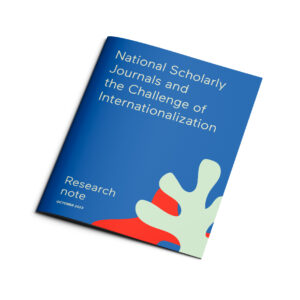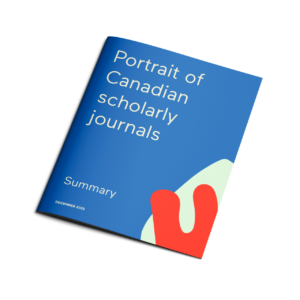
In honour of Canada Day, we’re delighted to share some of the reasons why we’re proud to be part of the Canadian scholarly journal landscape.
In this blog post, we present three recent studies, conducted by members of the Érudit and Coalition Publica research teams, that explore Canadian scholarly journals from every angle: open access, non-commercial infrastructures, research results, and much more!
Canadian journals and diamond open access: an open dataset
“The different journal profiles identified in this study testify to a very diverse landscape across Canadian provinces, open access types, management organizations and publication languages.” (van Bellen & Céspedes, 2024)
On April 16, the webinar Documenting the Canadian Scholarly Journals Landscape presented Coalition Publica’s detailed, open inventory of the historic and active journals that make up the national research dissemination landscape.
During the event, Érudit’s research team, made up of Simon van Bellen and Lucía Céspedes, shared the initial results of a preliminary study conducted using data from this directory. These results reveal the importance of diamond open access for the Canadian scholarly publishing ecosystem:
-
- Of the 943 currently active journals, 61% are diamond open access, which means that they are published and disseminated without any charge to authors or readers!
- The most recently established journals are predominantly in diamond open access: 84% of journals established since 2015 use this publication model.
- Of all the journals currently in open access, at least 1/4 have “flipped” to this mode of dissemination from a subscription-based model. The remaining journals have been in open access since their inception.
Canadian journals and international research
Using bibliometric methods, Simon van Bellen and Vincent Larivière (Professor at Université de Montréal’s École de bibliothéconomie et des sciences de l’information and Scientific Director of Érudit) examined the relationship between journals and Canadian researchers, particularly those working in French.
The resulting study, entitled “Canadian journals in the social sciences and humanities: Between national distribution and internationalization” (van Bellen & Larivière, 2024) and recently published in Recherches sociographiques, presents a number of interesting findings about the Canadian research ecosystem.
To better understand our country, there’s nothing like consulting its scholarly journals for access to Canadian research! Articles by Canadian authors published in domestic not-for-profit journals are two to three times more likely to present Canadian themes than those published in international commercial journals. The journals in which they appear are four times more likely to be open access.
In fact, when published in national not-for-profit journals, over 80% of articles by Canadian researchers in the humanities, social sciences and arts are available in open access.
Despite their richness, it is striking that the intensification of international collaborations between researchers tends to lead to a decline in research on issues specific to Canada, as well as in French-language publications, thus compromising the viability and sustainability of Canadian journals.
To learn more about the challenges of internationalizing research, read our research note.
Transformations in the Canadian scholarly journal ecosystem
“The way scholarly publishing is practiced has been turned upside down by digital technologies for over twenty years. The ways in which academic journals are funded, both in Canada and abroad, are being called into question by the shift to open access, which is accelerating and looks set to become widespread” (Larivière et al., 2021)
Conducted by a team led by Vincent Larivière, the study “Canadian scholarly journals in the humanities and social sciences: a quantitative and qualitative portrait” attempts to account for the upheaval in their funding methods linked to the advance of open access, in the broader context of the transformation of their practices by digital technologies.
By 2021, journals in the humanities and social sciences made up for a significant proportion of the research published in Canada, accounting for 74% of Canadian scholarly journals!
What’s more, “the Canadian academic publishing landscape differs markedly from the more oligopolistic situation internationally. In fact, there is very low concentration in scholarly publishing organizations and the vast majority are still affiliated to universities.” (Larivière et al., 2021)
The interviews conducted highlighted the financial needs of journals, whose revenues are often modest. The study confirms that a large majority of the humanities and social sciences journals studied depend on public subsidies, which account for between half and the total of all of their revenues. The transition to open access, which entails the loss of subscription revenues, the amounts of which vary widely from one journal to another, must therefore be the subject of careful financial planning.

